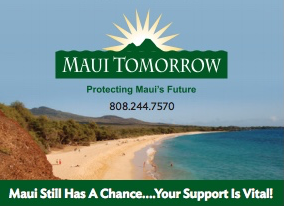Cane Burning, Wastewater & Axis Deer
by Ariel Stephens , The Maui Weekly
Last month, Rob Parsons, environmental coordinator for the office of Mayor Alan Arakawa, discussed the mayor’s environmental initiatives at a public meeting in Pukalani hosted by Upcountry Sustainability.
“Mayor Arakawa has made good on a campaign promise to focus on agriculture and the environment on Maui,” said Parsons. “We have worked to shift the governmental stance from reactive to pro-active.”
Parsons identified three areas that he believes are the top “eco-issues” in Maui County-renewable energy integration, wastewater disposal and axis deer culling…
“We need more UV pre-treatment of wastewater and more options for other eco-friendly uses of safe grey water,” said Parsons. “When I hear ‘wastewater,’ I think ‘wasted water.’ We may soon find ourselves in conditions where we don’t have the rainfall we’re accustomed to. We need to focus on purification technologies that may help us use this wasted resource for irrigation or other purposes.”…
…
The third issue discussed was cane burning. The mushroom clouds of smoke rising from burning cane fields are cause for great distress for many on the Valley Isle. The air pollution, the noxious smell and the falling ash impact a wide portion of Maui’s land and population.
The less visible affects are equally concerning. Parsons explained how “the mass tilling of many, many acres on a day with normal trade winds leads to a lot of fugitive dust, meaning, the loss of huge amounts of topsoil and the endangerment of things like the coral reefs in Ma’alaea due to soil dust settling into the ocean.”
Parsons also shared a list of crop control chemicals currently in use at HC&S-with ominous names like “triclopyr,” “oltrazine,” “oxyflurofen” and “hexazinone.”
The frustration in the crowd was palpable and audible. Parsons fielded dozens of questions and suggestions from concerned citizens, describing unsuccessful attempts over many years to lessen the environmental impact of HC&S’s actions. A proposal took form for scheduling of an all-inclusive community forum with representatives from the local and county government, HC&S, sustainability groups, the agricultural and farming industries and more. The hope was for a meeting at which “real change that satisfies all parties,” where a win-win solutions for both the sugar industry and the community could be discussed.
Although cane burning drew the strongest statements and the greatest frustration that night, other issues also inspired debate….


